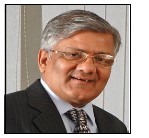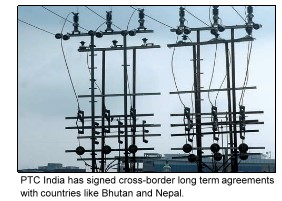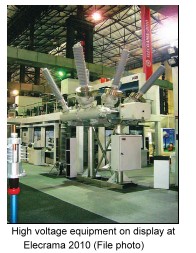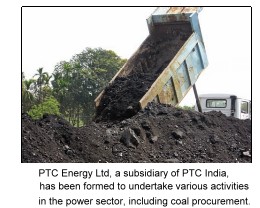 — Tantra Narayan Thakur,
CMD, PTC India Ltd
PTC India
— Tantra Narayan Thakur,
CMD, PTC India Ltd
PTC India (formerly Power Trading Corporation Ltd) represents
India's maiden effort in power trading. PTC is not only helping
create a vibrant power market in India, but is now turning as an
overall energy service provider, by promoting activities like power
exchanges, power financing, clean energy, etc.
Tantra Narayan
Thakur, in an exclusive interaction with Electrical Monitor, takes
us through the illustrious journey of PTC India and explains how
and why power trading will become a significant activity in the
coming years. An interview by
Venugopal Pillai.
PTC India represents India's pioneering endeavour in power
trading. Please summarize the current status of power trading
as a subject, and also take us through PTC India's growth in
recent years.
Yes, PTC has pioneered the development and implementation of
power trading in India and over the years has successfully
demonstrated its efficacy in optimally utilizing the existing
power infrastructure in the country.
Around 4 per cent to 5 per cent of total electricity generated in
the country is currently being traded in India in the short term.
With the implementation of National Electricity Policy, this
segment may grow up to 10-15 per cent in the next 4-5 years.
PTC's trading volume has grown at around 25-30 per cent per
annum during the past few years. Trading volume of PTC for the
financial year 2010-11 was 24,481 million kwh as compared to
18,236 million kwh during 2009-10, higher by 34 per cent.
As we understand, PTC India has entered into firm power
purchase agreements for 14,185 mw of power capacity as of
December 2010. Where do you see this number growing to by
December 2011 (say)?
The PPAs (power purchase agreements) signed by the company
as on March 31, 2011 are 14,804 mw, which excludes cross
border trade. In addition, we have also signed cumulative MoUs
for 12,356 mw. Active discussions are being held with the
developers for converting these MOUs into PPAs.
PTC has signed PPA with power projects which are expected
to be commissioned during the year and subsequent years.
About 2,100 mw of these projects have already started yielding
benefits for the company, these include projects like Lanco
Amarkantak-Phase I (300 mw), Torrent SUGEN (100 mw),
Baglihar HEP (225 mw), amongst others. I am sure we would be
able to maintain a growth rate of 25-30 per cent annually.
 PTC India promoted India Energy Exchange, which is India's
first power trading exchange. What has been IEX's performance
in recent months, and what is your view on the competition
arising from the entry of newer energy exchange players?
PTC India promoted India Energy Exchange, which is India's
first power trading exchange. What has been IEX's performance
in recent months, and what is your view on the competition
arising from the entry of newer energy exchange players?
PTC India through its subsidiary PTC India Financial Services is
a promoter of Indian Energy Exchange (IEX). Though initially
there were doubts about the performance of power exchange in
India, but IEX has had a good growth and participation in the
market since its inception in June, 2008.
Power exchanges provide a common platform to both buyers
and sellers and have largely helped in reducing the demand
supply gap across regions in India. India currently has two
active power exchanges namely Indian Energy Exchange and
Power Exchange of India Limited (PXIL). IEX has been
consistently enjoying a market share of more than 80 per cent
and PXIL having the remaining 20 per cent or so.
Trading volume on power exchanges and number of players are
increasing day by day. About 27 states and 990+ participants
(912 clients + 79 members) are participating on IEX.
Be it any sector or domain, it is always better to have
competition than having a monopoly. Similarly, competition
amongst the power exchanges has been good and in favor of the
consumers (buyer or seller), which eventually is the motive
behind creating such platforms. Competition between IEX and
PXIL has kept the pressure on both to perform and educate the
majority of the consumers of such platforms. Competition
amongst the exchanges would eventually push them to create
new and innovative products for their clients, thereby creating a
better market platform.
Merchant power plants, as we understand, would be the biggest
growth drivers for PTC India as their power generation is "free"
and not bound by PPAs. What is your view on the growth in the
Indian merchant power plant industry?
PTC focuses on the long term market through facilitation of
power projects being set up by Independent Power Producers
(IPPs) with whom it enters into long term PPAs and sells the
electricity being generated in the plant to various utilities
through long term back-to-back PSAs. Some capacities out of
those for which PTC signs long term PPAs is kept for short
term trading
Yes, it is correct that merchant power plants are going to be
one of the drivers in the growth of the power markets and shall
also contribute to PTC's growth. Some of the early movers have
reaped benefits and are in the process of adding new merchant
capacities. Many of the IPPs in recent times have also been
earmarking a part of their capacity (say 20-30 per cent) to be
traded in the merchant market. With commissioning of these
IPPs this additional merchant power is expected to lead to
further growth of the power market.
However, the growth of PTC would not only depend on the
merchant power but also the long term portfolio that PTC has
developed over the years. Obviously, there are risks associated
with the merchant capacities.
 Tell us about PTC India's cross-border electricity trading, and
what prospects do you see given that India is pursuing several
projects in hydropower-rich neighbouring countries like Nepal,
Bhutan and Bangladesh?
Tell us about PTC India's cross-border electricity trading, and
what prospects do you see given that India is pursuing several
projects in hydropower-rich neighbouring countries like Nepal,
Bhutan and Bangladesh?
PTC has signed long term agreements with Department of
Energy, Bhutan for purchase of surplus power to the tune of
1,416 mw. Around 5,569 million kwh of energy was imported in
2010-11 from Chukha, Kurichhu and Tala hydropower projects.
The sale of power through PTC is a significant source of revenue
income for Bhutan. Nepal wants to import thermal power from
India on long term basis and PTC has initialed a PPA for 150 mw
with Nepal Electricity Authority.
From time to time, we have also been selling power to Nepal
in shortage condition on short term basis. We are in dialogue
with the other neighbouring countries as well.
What positive impact do you see Power Grid Corporation of
India's National Grid having on large-scale power transmission
in the country, and how do you see PTC India benefiting from it?
Growth of power market in India has been closely linked with
the growth of the transmission inter-connections between
various electricity regions. Over the years, power transfer
capacity of the inter-regional grids has significantly improved
leading to formation of a national grid.
It is expected that by the end of XI Plan Period (2007-12), the
national grid capacity would be enhanced to more than 37,000
mw. Power transfers from surplus to deficit regions due to
seasonal and daily variations are possible only when there is
adequate transmission capacity enabling such transfers.
The strong national grid would help in growth of power
market in general. PTC being one of the key market players
would also be benefited from growth of such transmission interconnections
and a strong national grid.
 Electricity trading volumes in India are currently highly
incommensurate with power generation. What will be the key
determinants for this metric (power traded as percentage of
power generated) to improve in the coming years?
Electricity trading volumes in India are currently highly
incommensurate with power generation. What will be the key
determinants for this metric (power traded as percentage of
power generated) to improve in the coming years?
Trading of electricity is inherently volatile particularly because it is
demand sensitive depending on weather conditions and also
supply conditions. Further, the demand tends to be highly price elastic. It may be possible to reduce volatility of trading by carrying
out more accurate projections about the load and generation,
especially depending on weather forecast and seasonal aspects.
In a few years' time, 70-80 per cent of the traded electricity
through PTC would be going to be through long term contracts
(25 years or more). However, the balance 20-30 per cent
capacities are kept aside by us for use in the short term market
depending on location and tariff. Lenders and investors are
feeling more comfortable with this approach. The risk in short
term trading is mitigated through the long term contracts. Thus
more power will be available for market or for trading and also
will possibly ensure upside for investments.
As said earlier, around 4 per cent to 5 per cent of total
electricity generated in the country is currently being traded in
India in the short term. With the implementation of National
Electricity Policy, this segment may grow up to around 10 per
cent in the next 4-5 years.
By trading in power, PTC India also endeavours to correct the
imbalances in the electricity demand-supply situation in the
country. Please elaborate on this aspect and the degree of
success that PTC India has achieved in this pursuit.
Since its inception, PTC has taken upon itself the challenge of
creating awareness and acceptability to the concept of trading
in power. To begin with, the states producing or having surplus
power, after ascertaining states having shortage of power,
were vigorously persuaded by PTC India and to sell their surplus
power through PTC to deficit states at a mutually agreed
competitive tariff. This resulted in a win-win situation for both.
PTC successfully managed the marketing and credit risks as an
intermediary. This strategy turned out to be extremely
successful and added a new chapter to the history of power
sector in India by starting a process of setting right demandsupply
mismatch. It may not be out of place here and would not
be an exaggeration to say that the provisions relating to trading
and power market in the Electricity Act are largely because of
PTC's success in trading and establishing power market.
This strategy has led to optimal utilization of existing
assets to a large extent, at times without additional or
limited investment.
 In a very general sense, do you see that the "caps" prescribed on
energy trading by CERC adversely affecting PTC India's financial
returns? Please also share your general views on the electricity
pricing mechanism in the country.
In a very general sense, do you see that the "caps" prescribed on
energy trading by CERC adversely affecting PTC India's financial
returns? Please also share your general views on the electricity
pricing mechanism in the country.
CERC had introduced trading margin cap in the year 2004-05 as
4 paise/kwh and this cap remained in force for many years.
Trading margin cap has uniformly impacted the market players
as far as profitability is concerned.
CERC while maintaining trading cap of 4 paise/kwh for
electricity prices upto `3 per kwh, revised it upward to 7
paise/kwh for electricity price above `3 per kwh for the short
term market. Trading margin cap revision is a positive step
which we welcome. However, we have always maintained that
trading margin should not be a fixed number but interplay of
demand-supply and a "variable" depending on perceived risks
and expected returns associated with different nature of
transactions.
Market is a great leveler and will not allow intermediaries to
charge undue margins in a competitive situation, which is
getting intense with every passing day.
We learn that PTC India intends to diversify into a complete
energy solutions provider, through its subsidiary PTC Energy
Ltd. Please tell us more.
PTC Energy Ltd (PEL), wholly owned subsidiary of PTC India Ltd,
has been set up to undertake various activities related to power
and other sources of energy. The company has plan to enter into
the business of power generation, distribution, transmission,
import of coal, power tolling arrangements whereby, the
company shall procure coal for various power plants and pay an
energy conversion charge to the IPPs. The power generated
from such plants shall be owned by the company and sold to PTC
for trading. PEL has started its operations and we do hope that
in the years to come it will be coming to PTC's expectation.
PEL will be taking up various advisory assignments ranging
from study for marketing of power to preparing DPRs of power
projects, undertaking technical and commercial evaluation for
distribution reforms/ franchisee business etc.
During 2010-11, PTC Energy Ltd executed 280,492 tonnes of
spot sale/purchase of coal.
 What has been the current performance of PTC India Financial
Services and how do you gauge this subsidiary's prospects,
more so given its successful IPO recently? Please tell us
specifically about the equity investment by PFS in renewable
energy projects.
What has been the current performance of PTC India Financial
Services and how do you gauge this subsidiary's prospects,
more so given its successful IPO recently? Please tell us
specifically about the equity investment by PFS in renewable
energy projects.
Pursuant to receipt of the status of "Infrastructure Finance
Company" (IFC) by the Reserve Bank of India in August, 2010,
the company has successfully raised `42 crore though issuance
of Long Term Infrastructure Bond with benefits of Section-80
CCF of Income Tax Act, 1961.
PFS has signed an agreement for external commercial
borrowing (ECB) of $25 million from International Finance
Corporation on April 28, 2011. PFS has already signed
agreement for ECB of $26 million from DEG. PFS intends to sign
another ECB agreement with $25 million with IFC.
PFS has already raised its capital though issuance of new
share through IPO which was completed in March 2011. This
would help the company to increase its exposure limit in debt
financing to power projects as PFS can now take exposure in
debt financing up to `250 crore.
During 2010-11, PFS made disbursement of `801 crore as
compared to `246 crore in 2009-10, higher by 225 per cent. PFS
also has equity outstanding for FY11 at `459 crore as compared
to `370 crore in FY10, higher by 23.89 per cent.
PFS is very bullish on the renewable space. PFS has made
equity investment in biomass and wind energy farms. The
biomass project is commissioned and feeding green energy to
grid. Presently, investment of PFS in renewable space
constitutes 12-13 per cent.
Going forward, solar (thermal and photovoltaic) along with
wind will be a key growth driver for PFS in this space.
 Having started off as a power trader, PTC India has come a long
way in terms of its primary business and diversification into
several areas. What is your vision for PTC India in the years to
come, in terms of exploring new business areas?
Having started off as a power trader, PTC India has come a long
way in terms of its primary business and diversification into
several areas. What is your vision for PTC India in the years to
come, in terms of exploring new business areas?
Yes, power trading and development of power market in
India has been pioneered by PTC. Our efforts have been to
continuously innovate, understand the customer's needs
and design our products/ services around the same. This
has given us good business results and we will aim to
continue to do so.
We are also aggressively pursuing renewable energy and
energy efficiency projects into our fold of business, both by
promoting such projects as well as marketing of renewable
energy. These projects though small will become increasingly
lucrative in the years to come.